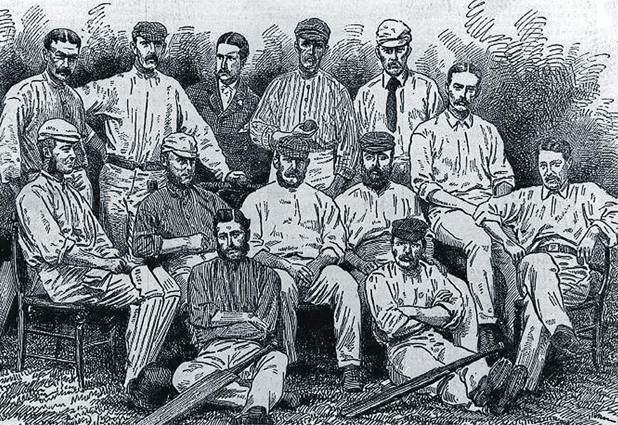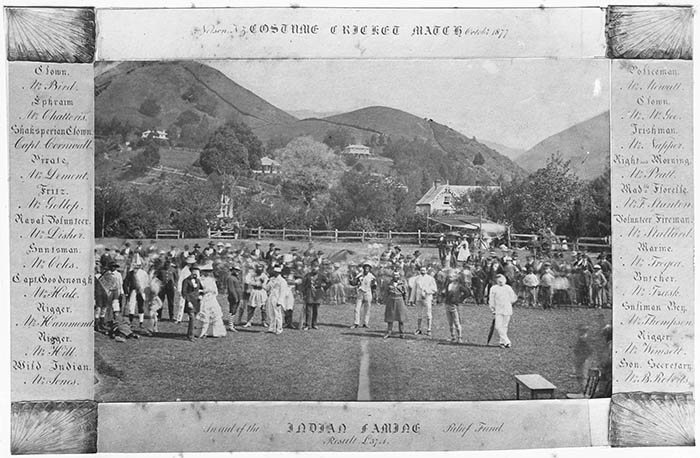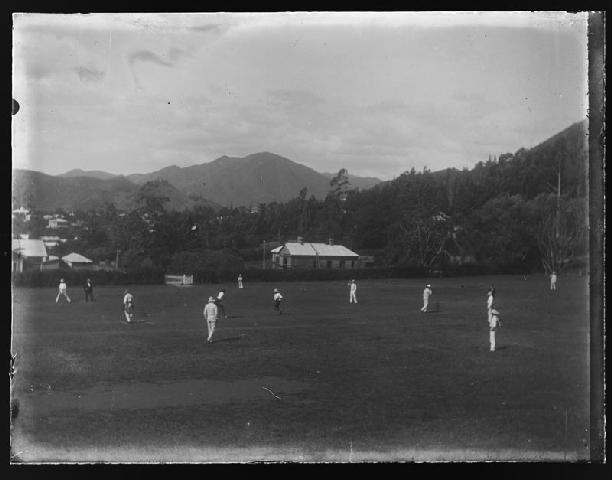Cricket in the Colonies
International cricket came to Nelson on January 4 2014, when the Black Caps took on the West Indies in a one-day international - New Zealand winning by 58 runs in a rain-interrupted match. This was not the first international cricket team to visit the city.
International cricket came to Nelson on January 4 2014, when the Black Caps took on the West Indies in a one-day international - New Zealand winning by 58 runs in a rain-interrupted match. This was not the first international cricket team to visit the city.
Just one month after comprehensively accounting for Nelson's batsmen, Alfred Shaw bowled test cricket's first ever ball. The bowling prodigy visited Nelson with James Lillywhite's XI in February 1877, before the English side sailed back to Australia where they were beaten in test cricket's inaugural contest.
The Antipodean tour was an ambitious undertaking by the Englishmen, who were away from home for well over six months, playing 23 cricket matches, including eight in New Zealand. Lillywhite's XI were the second international cricket team to visit this country, following George Parr's XI who played in Dunedin and Christchurch in 1864. The 1876-77 tour of Australia and New Zealand was an attempt to spread the reach of cricket further into the colonies.
Lillywhite had visited Australia in 1873-74 with a team captained by English cricketing deity W.G. Grace. Attempts had been made to entice that side across the Tasman to play matches in New Zealand, but the provinces would have to wait several years before they could witness the prowess of the English at a game that was in its infancy in New Zealand.
Prior to the Lillywhite XI departing, agents were sent to New Zealand to arrange fixtures and procure guarantees of £60 per match, along with the gate takings and a percentage of food and liquor sales. The promoters hoped this would cover the expected £6000 cost of the tour. Having played half of their matches in Australia, the English team departed Sydney for New Zealand on the Tararua on January 16 1877. While their first match in this country was to be against Auckland on Anniversary day, Lillywhite's XI made a stop in Nelson en route.
On 25 January the Nelson Evening Mail reported that the English had practised at Victory Square with some local cricketers:
"Our visitors rather astonished the spectators by showing what could be done with the ball by practised players," the journalist excitedly reported. "The bowling displayed great variety, swift and slow, twisters and shooters, and he must be a wary batsman who can make any long stand against the artillery brought to bear upon his wicket."
Having dispatched Auckland, Wellington, and Taranaki teams by more than innings, the James Lillywhite XI returned to Nelson.
Touring conditions for international cricketers in 1877 would certainly not be tolerated by their pampered modern counterparts. In Alfred Shaw's cricketing memoir His Career and Reminiscences, the bowler remembered the poor lodgings that met the English visitors on their late night arrival in Nelson:
"The hotel in which we had to stay possessed no beds beyond the family requirements," Shaw wrote. "We had, therefore, to rest in a large dining-room on rugs and shakedowns. There was a piano in the room, and the musical geniuses of the company contrived to keep themselves and everyone else awake the greater part of the night."
The three-day match against Nelson began on Wednesday, February 14, at Victory Square. The ground had been cleared of bush to create a cricket field when a Wellington team visited in 1862. The Lillywhite XI complimented the condition of the ground, noting that it was the best they'd encountered in New Zealand.
In "splendid cricketing weather" Lillywhite won the toss, and the match began just after 1pm, with the English batting. It was a different game of cricket to the modern version, with overs of just four balls, and under-arm bowling the custom. Further, due to the assumed superiority of the visitors, the provincial sides of Australia and New Zealand were required to field expanded sides so matches would last longer. While some fielded 18 players most, including Nelson, had a contingent of 22. Despite the numerical advantage, the local side struggled against the polished English visitors.
Shaw was a fine medium pace length bowler, whose first class wicket haul of 2027 at an average of 12.13 remains enviable. Lillywhite was a vastly experienced cricketer, opening batsman Henry Jupp scored over 15,000 runs in 378 first class matches, while George Ulyett was an incredibly prolific all-rounder, with more than 20,000 runs and 653 wickets in first class cricket.
Nelson's bowlers, especially Thomas Eden and Samuel Fowler, gamely tried to dismiss the English batsmen, but the visitors' careful, sophisticated batting saw them end the day on 142-1.
"It is not altogether flattering to our vanity when they express an expectation of making one of the largest scores they have yet made in New Zealand," Nelson's Colonist newspaper noted.
Thursday's play saw the Lillywhite XI dismissed, having accumulated 258 runs, with John Selby top-scoring with 82. Only three English bowlers were deployed over Nelson's two innings, with the follow-on being enforced. The local 22's first effort amounted to 56 runs, with Shaw capturing 13 wickets for 24 runs, while Allen Hill snared six wickets for 13 runs. There were 13 ducks, with the 19 extras being by far the highest contributor to the score.
Nelson's second innings was even more abject, amounting to just 39, as Shaw bettered his first innings effort by only giving away 19 runs for his 13-wicket haul. Thomas Emmett chipped in with seven wickets for 11 runs. The result had a Saturday column in the Nelson Evening Mail suggest that, "we have had just about enough cricket for one week".
"What do you say, all you noble army of martyrs to Hill's, Shaw's, and Emmett's bowling, who had to go back to the tent without cracking your duck's eggs? I think we must be content with our recent experience, and when next the English representatives pay a visit to the colony, suppose we say ‘Pass'."
Having thrashed Nelson by an innings and 163 runs, the James Lillywhite XI travelled on to Greymouth. They drew with Westland and Otago, beat Canterbury and Southland, endured a horrendous 60-hour journey over Arthur's Pass, and saw wicketkeeper Edward Pooley arrested after a brawl.
The English team sailed out of Invercargill in early March 1877, and into the annals of test cricketing history.
Cricket legends played in Nelson
First XI of notable cricketers who have played in Nelson:
- Fred Spofforth (February 1881) The "Demon Bowler" destroyed Nelson during Australia's first New Zealand tour. The following year he did the same to the English, inspiring the Ashes series.
- Victor Trumper (March 1914) Batting titan Trumper scored a half-century against Nelson towards the end of his storied Australian career. One of the "‘Six Giants of the Wisden Century", he died in Sydney a year later.
- Clarrie Grimmett (February 1928) Dunedin-born Grimmett played 37 tests for Australia, becoming the first cricketer to take 200 test wickets. He took seven Nelson, Marlborough and Westland wickets - including Sir Jack Newman's.
- Frank Woolley (December 1929) One of the greatest left-handed batsmen, English all-rounder Woolley was part of the MCC team that drew with Nelson. Wisden's 1911 Cricketer of the Year, his test career spanned 25 years.
- Sir Garfield Sobers (February 1956) Regarded as the greatest all-rounder of all time, the West Indian was on his first-ever tour in 1956. It was a miserable tour for the 19-year-old, and in Nelson he scored only 13 and 8, and took a single wicket.
- Dennis Lillee (February 1977) Lillee renewed his rivalry with Nelson's Jock Edwards as Australia beat Central Districts. Edwards was on 99 when he became one of the menacing fast bowler's four second innings victims.
- Greg Chappell (March 1982) Captain on the 1977 visit, Chappell returned with a team including Allan Border, Kim Hughes, Rod Marsh, and Jeff Thomson to beat Marlborough and Nelson comfortably.
- Sanath Jayasuriya (February 1991) Among the most successful ODI all-rounders, Jayasuriya's potential was emerging when Sri Lanka beat Central Districts, as he bashed 42 from 32 balls in the second innings.
- Graham Gooch (January 1992) Before World Cup Cricket fever gripped New Zealand, England's captain was in the midst of the golden period, scoring 64 in their second innings against a New Zealand XI.
- Shane Warne (February 1993) Warne was establishing his test career when he played a NZCC President's XI in Nelson. Australia lost, but four months later Warne bowled "the ball of the century" to Mike Gatting in the Ashes.
- Allan Donald (February 1995) Pace man Donald was typically devastating, claiming six scalps as South Africa beat the New Zealand Academy side by eight wickets.
First published in the Nelson Mail, 6 January 2014 (updated 2024)
![]()
Story by: Gavin Bertram
Further Sources
Books
- Neely, D. O. (2008) Men in white : the history of New Zealand test cricket. Auckland, N.Z. : Hodder Moa
http://www.worldcat.org/oclc/233970863
Newspapers
- The all England cricket match (1877, February, 14) The Colonist, p.3
http://paperspast.natlib.govt.nz/cgi-bin/paperspast?a=d&d=TC18770215.2.10 - Editorial (1877, January 25) Nelson Evening Mail, p.2
http://paperspast.natlib.govt.nz/cgi-bin/paperspast?a=d&d=NEM18770125.2.10 - The all England cricket match (1877, February 17) The Colonist, p. 3
http://paperspast.natlib.govt.nz/cgi-bin/paperspast?a=d&d=TC18770217.2.14 - The week (1877, February 17) Nelson Evening Mail, p. 2
http://paperspast.natlib.govt.nz/cgi-bin/paperspast?a=d&d=NEM18770217.2.12
Websites
- Nelson cricket. A brief history of cricket in the region. Retrieved 28 January, 2014:
http://nelsoncricket.org.nz/history/


